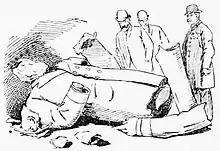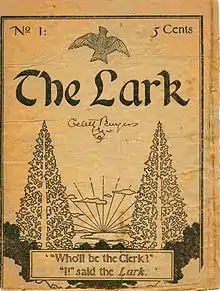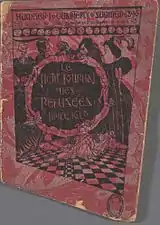Gelett Burgess
Frank Gelett Burgess (January 30, 1866 – September 18, 1951) was an American artist, art critic, poet, author and humorist. An important figure in the San Francisco Bay Area literary renaissance of the 1890s, particularly through his iconoclastic little magazine, The Lark, he is best known as a writer of nonsense verse, such as "The Purple Cow", and for introducing French modern art to the United States in an essay titled "The Wild Men of Paris". He was the author of the popular Goops books, and he coined the term blurb.
Gelett Burgess | |
|---|---|
 Circa 1910 | |
| Born | Frank Gelett Burgess January 30, 1866 Boston, United States |
| Died | September 18, 1951 (aged 85) Carmel, CA |
| Occupation | Novelist, Engineer |
| Nationality | American |
| Literary movement | West Coast Response to the European Decadent movement |
| Notable works | The Purple Cow, The Wild Men of Paris |
Early life
Born in Boston, Burgess was "raised among staid, conservative New England gentry".[1] He attended the Massachusetts Institute of Technology, graduating with a B.S. in 1887. After graduation, Burgess fled conservative Boston for the livelier bohemia of San Francisco, where he worked as a draftsman for the Southern Pacific Railroad. In 1891, he was hired by the University of California at Berkeley as an instructor of topographical drawing.
Cogswell fountain incident
In 1894, Burgess lost his job at Berkeley as a result of his involvement in an attack on one of San Francisco's three Cogswell fountains, free water fountains named after the pro-temperance advocate Henry Cogswell who had donated them to the city in 1883. As The San Francisco Call noted a year before the incident, Cogswell's message, combined with his enormous image, irritated many:
It is supposed to convey a lesson on temperance, as the doctor stands proudly on the pedestal, with his whiskers flung to the rippling breezes. In his right hand he holds a temperance pledge rolled up like a sausage, and the other used to contain a goblet overflowing with heaven's own nectar. But wicked boys shattered the emblem of teetotalism with their pea-shooters and now the doctor's heart is heavy within him.[2]
In response, numerous acts of minor vandalism had been inflicted upon the fountain.
Four iron posts with ornate lamps at the top originally graced the corners of this gurgling example of temperance, but now they lean and lurch and pitch like a drunken quadrille. Beer wagons heavy laden humped into the posts, shattered the stained-glass lamps and destroyed their equilibrium. Some of the lamps are canted over like a tipsy man's hat, and the whole group presents a most convivial aspect.[3]

The toppling incident took place in the early hours of January 1, 1894. As the Call reported,
Some iconoclastic spirits, probably made bold by too freely indulging in the convivialities of New Year's day, found vent for their destructive proclivities in the small hours of the morning yesterday. With the greatest deliberation, apparently, a rope was coiled around the mock presentment of Dr. Cogswell and with a strong pull, and all together, he was toppled from his fountain pedestal at the Junction of California and Market streets.[4]
The newspaper noted that "no one professes to have knowledge of the perpetrators of the outrage," and no arrests had been, or were, made. However, Burgess's involvement was suspected and is generally viewed as the reason for his resignation from the university, reported by the Call on March 10, 1894, with the note that the resignation was "to take effect with the close of the year."[5]
Burgess is now held in high regard at the University of California, Berkeley as a former professor and literary talent. A selection of his original works and his papers are housed in the Bancroft Library on the Berkeley campus.
The Lark and its descendants

Burgess's departure from the University became an opportunity to reconsider his professional aspirations. With a group of like-minded associates, he founded in 1895 a humorous little magazine entitled The Lark.
The Lark began as a lark, but was more successful than its makers intended, eventually reaching a circulation of over 3,000. Before the official publication date, local publisher/bookseller William Doxey, intrigued by the first number, agreed to act as official publisher of the venture. Volume 1, number 1 of the 16-page monthly appeared on May Day: May 1, 1895.

I never saw a purple cow
I never hope to see one;
But I can tell you, anyhow,
I'd rather see than be one!
"The Purple Cow" (the full title was "The Purple Cow: Reflections on a Mythic Beast Who's Quite Remarkable, at Least"), an illustrated four-line poem that appeared in the first number of The Lark, was to remain the ne plus ultra of nonsense verse that Burgess would spend his life unsuccessfully attempting to surpass.
At first, the magazine was edited and written primarily by Burgess, who took great delight in creating pseudonyms for himself. For example, in volume 1, four of the other "authors" are Burgess writing under different names.
Burgess was initially assisted by writer-artist Bruce Porter. The magazine soon attracted an eclectic group of contributors, who became known as "Les jeunes." These included Porter Garnett (who also took on editorial responsibilities), Carolyn Wells, Willis Polk, Yone Noguchi, and others. Local artists, including Ernest Peixotto, Florence Lundborg and Maynard Dixon, contributed illustrations and cover designs.

Number 24 of The Lark (April 1897) was declared to be the last, but a final issue, number 25 entitled The Epi-Lark, was published May 1, 1897.[6]
By this point, Burgess had become thoroughly sick of "The Purple Cow," and wrote the following "Confession: and a Portrait Too, Upon a Background that I Rue" in The Lark, number 24 (April 1, 1897).
Ah, yes, I wrote the "Purple Cow"—
I'm Sorry, now, I wrote it;
But I can tell you Anyhow
I'll Kill you if you Quote it!
"Purple Cow" has been used as a brand name.
Subsequently, Burgess and publisher William Doxey recycled Burgess's contributions in such productions as The Purple Cow (1899)[7] and The Lark Almanack (1899).[8]
Another Lark spinoff, created by Burgess and friends one night in 1896, is Le Petit Journal des Refusées.[9] Purporting to be composed of material written by women and rejected by other magazines, Le Petit Journal des Refusées was printed on wallpaper and cut to an irregular shape. It was announced with a mock call for submissions in the sixth issue of The Lark.[10]
New York, France, later life
Burgess moved to New York City, where he wrote several books and articles for magazines including The Smart Set, Collier's, and Century. He made several trips to France and was evidently fluent in French. Eventually he returned to California, where he died in Carmel-by-the-Sea in 1951.
In 1919, Rollin Lynde Hartt published an article about Burgess as one of "the funniest men who ever lived," which appeared in newspapers nationwide.
Burgess married Estelle Loomis at a Unitarian church in New York City in June 1914, and they were honeymooning in France when World War I broke out.[11] A writer in her own right, Estelle Loomis worked on a number of literary projects throughout her marriage with Burgess, the two conferring together on each other's work. She was also an actress and a beauty contest winner.[12] She was photographed shortly before their marriage by Arnold Genthe. Burgess and Loomis remained married until her death in 1946; however, she frequently suffered from illness and fatigue. They remained childless.
The Wild Men of Paris
Leading up to 1910, one year before the scandalous group exhibiting that brought "Cubism" to the attention of the general public, Burgess wrote an influential article titled, The Wild Men of Paris. This illustrated text introduced Proto-Cubist art in the United States for the first time. It included the first reproduction of Pablo Picasso's Les Demoiselles d'Avignon.
Written after his visit to the 1910 Salon des Indépendants—the well-established anti-establishment art exhibition in Paris—the article drew from interviews with Henri Matisse, Pablo Picasso, Georges Braque, André Derain, Othon Friesz, Jean Metzinger, Auguste Herbin and Béla Czóbel.[13] The Wild Men of Paris was partly humorous but partly serious.
Burgess wrote of Matisse's 1907 painting Blue Nude (Souvenir de Biskra) in humorist fashion:
There were no limits to the audacity and the ugliness of the canvasses. Still-life sketches of round, round apples and yellow, yellow oranges, on square, square tables, seen in impossible perspective; landscapes of squirming trees, with blobs of virgin color gone wrong, fierce greens and coruscating yellows, violent purples, sickening reds and shuddering blues.
But the nudes! They looked like flayed Martians, like pathological charts—hideous old women, patched with gruesome hues, lopsided, with arms like the arms of a Swastika, sprawling on vivid backgrounds, or frozen stiffly upright, glaring through misshapen eyes, with noses or fingers missing. They defied anatomy, physiology, almost geometry itself![14]
Other works
Burgess's completely serious writings include "War the Creator",[15] an account of a young man he had met in Paris in July 1914, and saw again as a wounded soldier a few months later: "a boy who, in two months, became a man."
Burgess wrote and illustrated several children's books about the habits of strange, baldheaded, idiosyncratic childlike creatures he called the Goops. He created the syndicated comic strip Goops in 1924, and worked on it to its end in 1925.[16]
His books The Maxims of Methuselah and The Maxims of Noah were illustrated by Louis D. Fancher.
Legacy

The word "blurb", meaning a short description of a book, film, or other product written for promotional purposes, was coined by Burgess in 1907, in attributing the cover copy of his book, Are You a Bromide?, to a Miss Belinda Blurb. His definition of "blurb" is "a flamboyant advertisement; an inspired testimonial".[17]
In that book "Are You a Bromide?" and related essay "The Sulphitic Theory", Burgess is credited for coining the usage of the word "bromide" as a personification of a sedate, dull person who said boring things.[18] Bromide meant either the boring person himself or the trite statement of that person.
He also coined the phrase, "Love is only chatter; friends are all that matter."
The Gelett Burgess Center for Creative Expression was formed in Burgess's name in December 2011 to promote "family-friendly books" to parents and educators. Annually, the Gelett Burgess Children's Book Award is given in his honor to the top children's books of the year.[19]
Burgess founded the San Francisco Boys' Club Association, now the Boys & Girls Clubs of San Francisco, in 1891 and became its first president. The Club was the first of its kind west of the Mississippi River.[20]
Burgess was a friend of the British writer Oliver Onions, and encouraged Onions to write fiction.[21]
Works
- "Vivette" (1897); novelette
- The Lively City O'Ligg (1899); juvenile
- Goops, and How to be Them (1900); juvenile
- A Gage of Youth (1901); poems, chiefly from The Lark
- The Burgess Nonsense Book (1901); prose and verse
- The Romance of the Commonplace (1901)
- More Goops, and How Not to Be Them (1903); juvenile
- The Reign of Queen Isyl (1903); short stories in collaboration with Will Irwin
- The Picaroons (1904); short stories in collaboration with Will Irwin
- The Rubaiyat of Omar Cayenne (1904); satire
- Goop Tales (1904); juvenile
- A Little Sister of Destiny (1904); short stories
- Are You a Bromide? (1906); short book, Open source e-book (California Digital Library)
- The White Cat (1907); novel
- The Heart Line (1907); novel, e-book (Internet Archive)
- The Maxims of Methuselah (1907); satire
- Blue Goops and Red (1909); juvenile
- Lady Mechante (1909); novel
- Find the Woman (1911); novel
- The Master of Mysteries (1912)
- The Maxims of Noah (1913)
- "War, the Creator" (magazine essay 1915, book 1916)
- Mrs. Hope's Husband (1917)
- The Goop Encyclopedia: Containing Every Child's Every Fault (1916); juvenile
- Have You an Educated Heart? (1923)
- Ain't Angie Awful (1923)
- Why Men Hate Women (1927)
- Look Eleven Years Younger (1937)
Notes
- John Wenke, "Gelett Burgess", Dictionary of Literary Biography, Volume 11: American Humorists, 1800–1950. Ed. Stanley Trachtenberg (Gale, 1982), p. 68.
- "His Soul Was Sad: Dr. Cogswell a Victim of Ingratitude," The San Francisco Call, 2 March 1893, 8.
- "His Soul Was Sad", The San Francisco Call, 8.
- "Image Breakers: Dr. Cogswell's Stature Overturned Under Shadow of Night by a Silent Gang of Hoodlum Miscreants", The San Francisco Call, 3 Jan. 1894, 8.
- "Resigned," The San Francisco Call, 10 March 1894, 7.
- Wells, Carolyn: "What a Lark!" in The Colophon, pt. 8, ed. Elmer Adler, Burton Emmet, John T. Winterich. New York, 1931.
- Gelett Burgess, The Purple Cow, San Francisco: Doxey, 1899
- The Lark Almanack, San Francisco: Doxey, 1899.
- Johanna Drucker, "Le Petit Journal des Refusées", Connexions, June 3, 2009
- Johanna Drucker, "Bohemian by Design: Gelett Burgess and Le Petit Journal des Refusées"
- MIT Technology Review, vol. 16, p. 480
- Scranton Times in September 1920: "Scranton woman second place in NY World beauty contest, Mrs. Gelett Burgess, Riverside Drive, NY, formerly Miss Estelle Loomis, daughter of the late F. E. Loomis, attorney."
- The Wild Men of Paris, Architectural Record, May 1910.
- Gelett Burgess (May 1910, "The Wild Men of Paris", Architectural Record, p. 400 (PDF)
- "War the Creator"
- Strickler, Dave. Syndicated Comic Strips and Artists, 1924–1995: The Complete Index. Cambria, California: Comics Access, 1995. ISBN 0-9700077-0-1
- Burgess Unabridged, a New Dictionary of Words You Have Always Needed (1914), (Archon Books, 1986), p. 7; see also the etymology at "Blurb", Merriam-Webster, retrieved June 4, 2008.
- Metcalf, Alan A. (2004). Predicting New Words - The Secrets of Their Success. Boston: Houghton Mifflin Harcourt. pp. 36-42. ISBN 0-618-13006-3. Retrieved August 27, 2017.
- Gelett Burgess Center for Creative Expression
- "A San Francisco Boys Club," The Pacific Unitarian 1:6 (April 1893), p. 166
- "Oliver Onions" in Kunitz, Stanley J.; Haycraft, Howard, eds. (1950). Twentieth Century Authors: A Biographical Dictionary of Modern Literature (3rd ed.). New York: H. W. Wilson. pp. 1051–52
References
- Bleiler, Everett (1948). The Checklist of Fantastic Literature. Chicago: Shasta Publishers. p. 65.
External links
| Wikimedia Commons has media related to Frank Gelett Burgess. |
| Wikiquote has quotations related to: Gelett Burgess |
| Wikisource has original works written by or about: Frank Gelett Burgess |
| Wikisource has the text of the 1921 Collier's Encyclopedia article Burgess, (Frank) Gelett. |
- U of Toronto Representative Poetry Online: Gelett Burgess
- Works by Gelett Burgess at Project Gutenberg
- Works by or about Gelett Burgess at Internet Archive
- Works by Gelett Burgess at LibriVox (public domain audiobooks)

- Guide to the Gelett Burgess Papers at The Bancroft Library
- Burgess's "The Ghost-Extinguisher" read in Mister Ron's Basement Podcast
- The Lively City O'Ligg (1899) openly available in the University of Florida Digital Collections
- Music set to Burgess poems "The Knave of Hearts", "The Purple Cow", and more